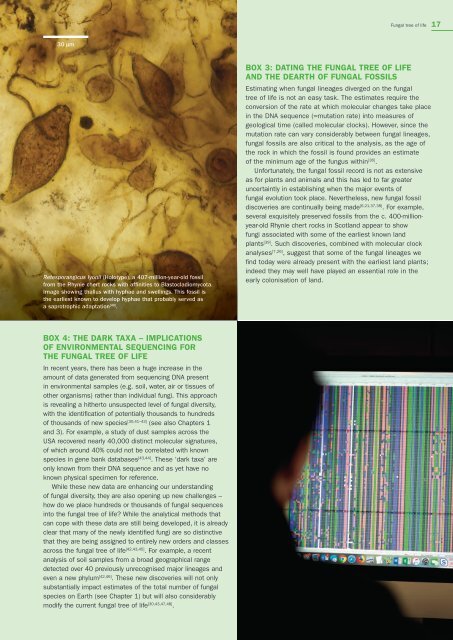gom1
Create successful ePaper yourself
Turn your PDF publications into a flip-book with our unique Google optimized e-Paper software.
Fungal tree of life 17<br />
30 μm<br />
Retesporangicus lyonii (Holotype), a 407-million-year-old fossil<br />
from the Rhynie chert rocks with affinities to Blastocladiomycota.<br />
Image showing thallus with hyphae and swellings. This fossil is<br />
the earliest known to develop hyphae that probably served as<br />
a saprotrophic adaptation [40] .<br />
BOX 3: DATING THE FUNGAL TREE OF LIFE<br />
AND THE DEARTH OF FUNGAL FOSSILS<br />
Estimating when fungal lineages diverged on the fungal<br />
tree of life is not an easy task. The estimates require the<br />
conversion of the rate at which molecular changes take place<br />
in the DNA sequence (=mutation rate) into measures of<br />
geological time (called molecular clocks). However, since the<br />
mutation rate can vary considerably between fungal lineages,<br />
fungal fossils are also critical to the analysis, as the age of<br />
the rock in which the fossil is found provides an estimate<br />
of the minimum age of the fungus within [36] .<br />
Unfortunately, the fungal fossil record is not as extensive<br />
as for plants and animals and this has led to far greater<br />
uncertaintly in establishing when the major events of<br />
fungal evolution took place. Nevertheless, new fungal fossil<br />
discoveries are continually being made [6,21,37,38] . For example,<br />
several exquisitely preserved fossils from the c. 400-millionyear-old<br />
Rhynie chert rocks in Scotland appear to show<br />
fungi associated with some of the earliest known land<br />
plants [39] . Such discoveries, combined with molecular clock<br />
analyses [7,26] , suggest that some of the fungal lineages we<br />
find today were already present with the earliest land plants;<br />
indeed they may well have played an essential role in the<br />
early colonisation of land.<br />
BOX 4: THE DARK TAXA – IMPLICATIONS<br />
OF ENVIRONMENTAL SEQUENCING FOR<br />
THE FUNGAL TREE OF LIFE<br />
In recent years, there has been a huge increase in the<br />
amount of data generated from sequencing DNA present<br />
in environmental samples (e.g. soil, water, air or tissues of<br />
other organisms) rather than individual fungi. This approach<br />
is revealing a hitherto unsuspected level of fungal diversity,<br />
with the identification of potentially thousands to hundreds<br />
of thousands of new species [30,41–43] (see also Chapters 1<br />
and 3). For example, a study of dust samples across the<br />
USA recovered nearly 40,000 distinct molecular signatures,<br />
of which around 40% could not be correlated with known<br />
species in gene bank databases [43,44] . These ‘dark taxa’ are<br />
only known from their DNA sequence and as yet have no<br />
known physical specimen for reference.<br />
While these new data are enhancing our understanding<br />
of fungal diversity, they are also opening up new challenges –<br />
how do we place hundreds or thousands of fungal sequences<br />
into the fungal tree of life? While the analytical methods that<br />
can cope with these data are still being developed, it is already<br />
clear that many of the newly identified fungi are so distinctive<br />
that they are being assigned to entirely new orders and classes<br />
across the fungal tree of life [42,43,45] . For example, a recent<br />
analysis of soil samples from a broad geographical range<br />
detected over 40 previously unrecognised major lineages and<br />
even a new phylum [42,46] . These new discoveries will not only<br />
substantially impact estimates of the total number of fungal<br />
species on Earth (see Chapter 1) but will also considerably<br />
modify the current fungal tree of life [30,43,47,48] .

















